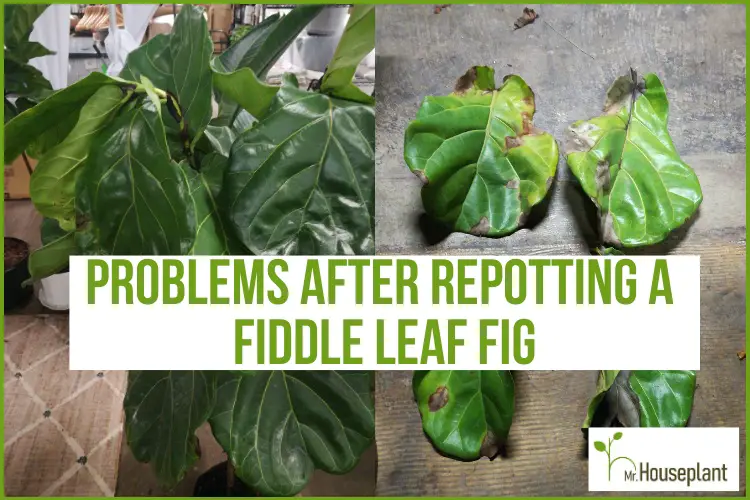
You were hoping that your Fiddle Leaf Fig will perk up after repotting but it started slouching instead. How to recognize and deal with transplant shock? Read on to learn about problems after repotting a Fiddle Leaf Fig and how to fix them.
How To Recognize A Fiddle Leaf Fig Shock After Repotting?
To recognize a Fiddle Leaf Fig shock after repotting, take a look at its leaves and its overall appearance:
- Is your Fiddle Leaf Fig slouching after repotting?
- Do leaves appear droopy?
- Have you noticed some leaf drop from your Fiddle Leaf Fig tree?
- Are there any brown spots or brown leaf edges?
These are all telltale signs that your plant is experiencing transplant shock. No reason to panic – leaf drop and some drooping after repotting is to be expected. The reason is that Fiddle Leaf Figs don’t enjoy change. And since you moved yours to a new environment, the plant underwent considerable stress. So be patient and give it time to overcome the shock from being moved.
Should you be worried if you recognize a Fiddle Leaf Fig shock? Not at all – but only if your plant has optimum conditions to recover from repotting. That means the Fig must get a sufficient amount of light (direct sunlight or bright indirect light), a suitable watering schedule, and the right type of potting soil. So once you’re positive the environment is optimal, leave your Fiddle Leaf Fig alone. Let it sulk over the move – now is not the time to move the plant around looking for a new spot, try out new fertilizer, or get extra with the amount of water.
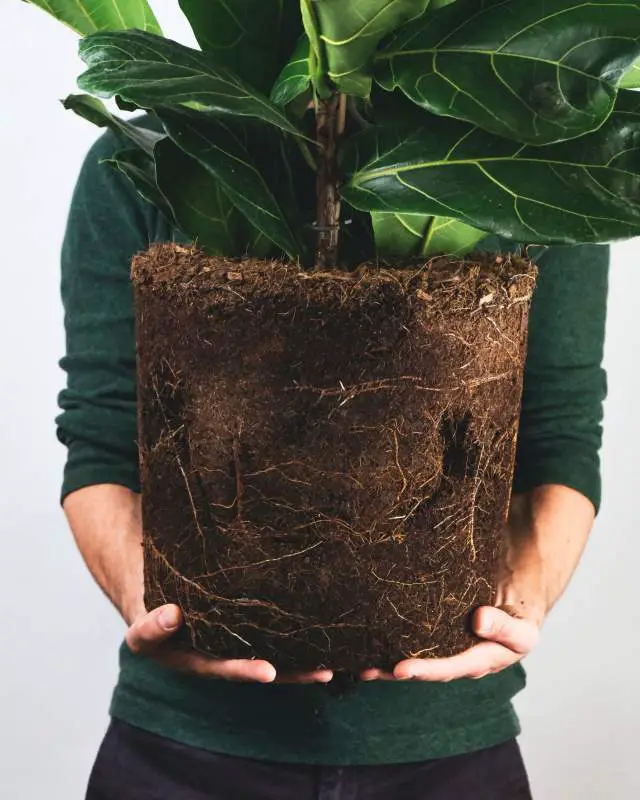
Ficus Lyrata without a nursery pot
Why Is Fiddle Leaf Fig Dropping Leaves After Repotting?
There are several reasons why Fiddle Leaf Fig is dropping leaves after repotting:
- Too much moisture. If the soil stays wet for too long, Fiddle Leaf Fig’s roots may rot. This results in leaf drop. Most Fiddle Leaf Fig owners water the soil after repotting process. And that’s fine – watering is the right thing to do when you move the plant to a new nursery pot! Just make sure you’re not overwatering. Also, the soil mix must be well-draining so your plant wouldn’t stay wet for too long. Any excess water should be removed from the plant saucer after watering. Otherwise, it may cause root rot.
- Stress. Another reason for dropping leaves may have to do with the stress the plant is experiencing from being moved. Fiddle Leaf Figs thrive best in a consistent environment and any change may make them “throw a fit”.
- The pot is too large. If the new container is too big for your Fig’s size, the plant’s roots will dry out slower. This can cause rotten roots and lead to dropping leaves. When repotting Fiddle Leaf Figs, choose a pot that’s about two inches larger than the previous one.
- Underwatering. Fiddle Leaf soil can’t be too wet but can’t be too dry either. If your plant gets too much direct sunlight but not enough water, it may drop leaves. To fix this, adjust the watering schedule. A moisture meter can also be quite handy for checking how moist the soil is.
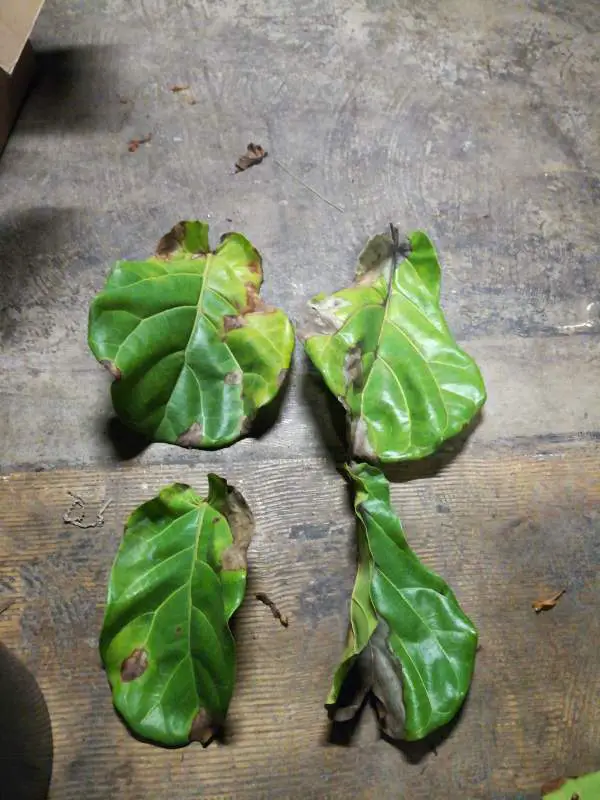
Fiddle Leaf Fig leaves dropped because of underwatering
Why Has My Fiddle Leaf Fig Stopped Growing After Repotting?
Your Fiddle Leaf Fig has stopped growing after repotting because of the transplant shock. After repotting, roots need time to adjust to a new environment. Slow growth in the first few weeks or longer is nothing to be worried about. After a while, they will start actively growing again.
Why Is Fiddle Leaf Fig Wilting After Repotting?
The reason why Fiddle Leaf Fig is wilting after repotting is because of root shock. Changes in the environment, as well as changes in the plant’s routine, may cause it to slouch. Droop mode is not unusual for repotted plants. Be sure not to do anything more. Let the Fiddle Leaf Fig plant recover. It should perk back up within a week or so.
Note that chronic underwatering may also lead to wilting, leaves curling, and the death of your plant. To avoid this, water your Fig thoroughly after moving it to a larger pot. Also, stick to the right watering schedule.
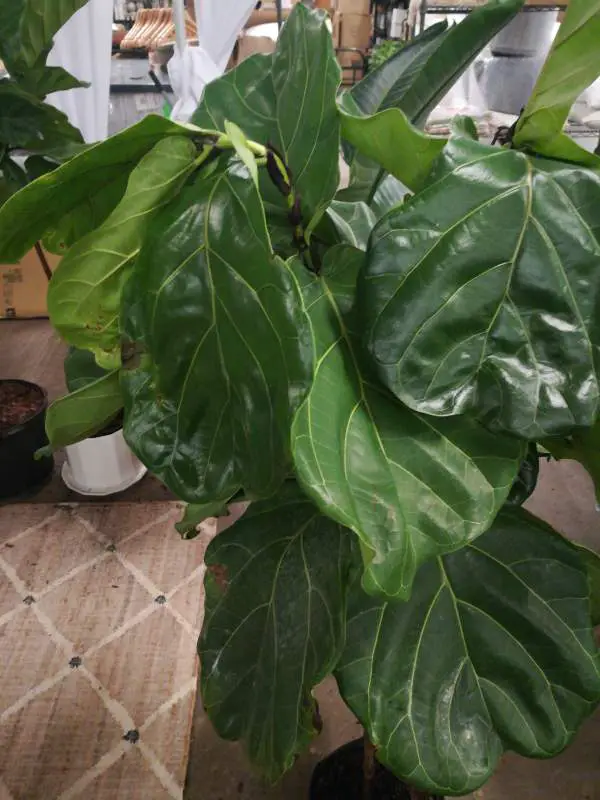
Fiddle Leaf Fig drooping leaves due to lack of water
Why Fiddle Leaf Fig Leaves Turn Yellow After Repotting?
The reason why Fiddle Leaf Fig leaves turn yellow after repotting is because of:
- Too much moisture. When Fiddle Leaf Fig soil is wet for too long, this leads to root rot. As a result, leaves turn yellow. How to prevent root rot caused by too much moisture? First, don’t overwater the plant. Let the soil dry out completely between watering. Next, ensure proper drainage system. Use a well-draining potting soil mix. Make sure the pot has drainage holes. If possible, go for terracotta pots instead of plastic ones. It will absorb some of the moisture, further improving the drainage system.
- Not enough light or nutrients. Insufficient light combined with a lack of nutrients almost always leads to problems after repotting a Fiddle Leaf Fig. How to prevent Fiddle Leaf Fig leaves from turning yellow after you move it to a new pot? First, check the light exposure. If your Fig isn’t getting at least 5,000 Lux (500 FC), find a new spot with plenty of bright light. Alternatively, you can use grow lights to mimic natural light. Next, get rid of old soil when repotting. Use fresh new soil that has plenty of nutrients for healthy growth.
Why Fiddle Leaf Fig LeavesTurn Brown After Repotting?
Fiddle Leaf Fig’s leaves turn brown after repotting because of one or more of the following issues:
- Too much moisture. Poor drainage and wrong potting soil mix combined with insufficient light exposure and overwatering lead to soil staying wet for too long. This causes root rot and eventually affects leaves. If you notice brown spots on older leaves and near the bottom of the plant, then you’re probably dealing with root rot. Brown spots will become bigger over time until they fall off. Take the plant out of its pot and inspect the roots to determine whether root rot is the issue.
- Not enough water. Brown areas that start at the edge of the leaf and cause it to curl usually come from dryness. This is one of the common problems after repotting a Fiddle Leaf Fig but it is easy to fix. You may have forgotten to water your plant. Or the Fiddle Leaf plant is in a dry environment. If the soil shrinks from dryness, water can not reach the root ball. When the root system doesn’t get enough water, leaves will turn brown and start curling.
- Bacterial infection. If you see many brown spots and not just one brown area, it can indicate bacterial infection. How to tell a difference between root rot and bacterial infection? Bacterial spots usually have irregular margins. They can attack both older and younger leaves and can occur anywhere on the leaf, including edges, middle parts, and all the way to the stem. Bacterial spots will cause many spots per leaf, not just one. In case your Fiddle Leaf Fig suffers from a bacterial infection, it’s recommended to remove all affected foliage. You can’t really heal the infected sections, but you can treat them with a fungicide to prevent the infection from spreading.
- Insect damage. This is one of the least common problems after repotting a Fiddle Leaf Fig. You will recognize it by the small red or dark spots that sometimes might turn into holes. New leaves are usually more affected than older growth. You might also notice webbing on the leaves in case of spider mites. Luckily, this issue is easy to solve. Try using neem oil or insecticidal soap to get rid of insects on your plant.
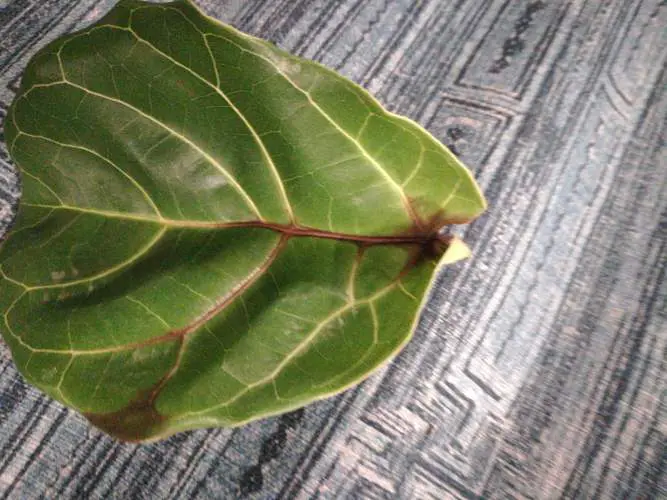
Leaves turning brown due to overwatering
Wilting, drooping, yellow leaves, brown spots, and crispy brown leaf edges are only a few of the issues plant parents may have to deal with. The good news is that most problems after repotting a Fiddle Leaf Fig can be easily fixed, as long as you react fast. To prevent potential issues, follow a simple recipe for a healthy tree. Use a well-draining potting soil mix, provide your plant with plenty of light, and find the right watering schedule for your specific Fiddle Leaf Fig.
Yours Truly,


Related Posts
Fiddle Leaf Fig Problems (And HOW TO Treat Them)
Anthurium Vittarifolium Vs Pallidiflorum (4 easy TIPS!)
Trimming a Spider Plant (ALL You Need To Know!)